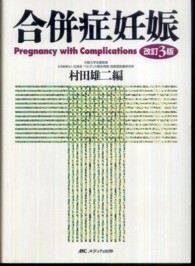- ホーム
- > 洋書
- > 英文書
- > History / World
Full Description
How women increasingly became economic agents in early modern Europe is the focus of this stimulating book, which highlights how female agency was crucial for understanding the development of the Western European economy and sheds light on economic development today.
Jan Luiten van Zanden, Tine De Moor and Sarah Carmichael argue that over centuries a "European Marriage Pattern" developed, characterized by high numbers of singles among men and women, high marriage ages among men and women, and neolocality, where the couple forms a new nuclear household and did not co-reside with the parents of either bride or groom. This was due to the influence of the Catholic Church's teachings of marriage based on consensus, the rise of labor markets, and institutions concerning property transfers between generations that enhanced wage labor by women. Over time an unprecedented demographic regime was created and embedded in a highly commercial environment in which households interacted frequently with labor, capital and commodity markets. This was one of the main causes of the gradual move away from a Malthusian state towards an economy able to generate long-term economic growth.
The authors explore how the pattern was influenced by and influenced female human capital formation, access to the capital market, and participation in the labor market. They use numerous measures of economic activity, including the unique "Girlpower-Index" that measures the average age at first marriage of women minus the spousal age gap, with higher absolute age at marriage and lower spousal age gap both indicating greater female agency and autonomy.
The book also examines how this measure can increase understanding of contemporary dynamics of women and the economy. The authors thus shed light on the degree to which women are allowed to play an influential role in and on the economy and society, which varies greatly from one society to another.
Contents
List of Figures
List of Tables
Acknowledgments
1. The broader picture: the global determinants of female agency and economic growth
2. The patterns behind change: origins and features of the European Marriage Pattern
3. Effects on human capital formation
4. Effect on capital market development
5. The effect on the labour market: women's wages, human capital formation and fertility
6. The 'dark side' of the EMP? Testing the nuclear hardship hypothesis
7. The institutional effect: alternatives for family ties, the role of trust and the emergence of the commercial household
8. Beguines: living single and safe
9. Conclusion: the EMP in Eurasian Perspective
References
Index








